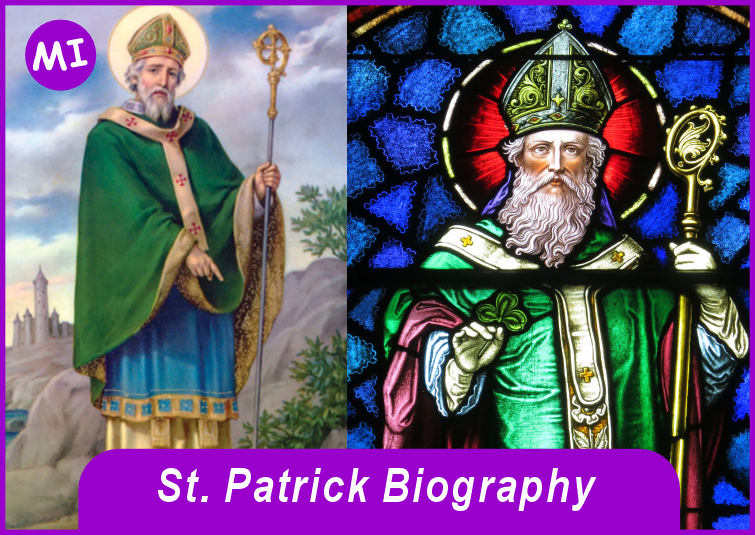
St. Patrick Biography – Discover the life of St. Patrick, the patron saint of Ireland. Learn about his early life, missionary work, St. Patrick’s Day celebrations, cathedrals dedicated to him, and his lasting legacy.
St. Patrick is one of the most revered figures in Irish history, known for bringing Christianity to Ireland and driving out the “snakes”, a metaphor for pagan practices. Although much of his life remains shrouded in legend, his influence on Irish culture and Christianity is undeniable. Every year on March 17, St. Patrick’s Day is celebrated worldwide, honoring his mission and contributions. His legacy lives on in churches, cathedrals, and annual parades, making him one of the most recognized saints in the world.
St. Patrick Biography: Profile Summary
| Field | Details |
|---|---|
| Name | St. Patrick |
| Profession | Christian Missionary, Bishop |
| Nationality | Romano-British |
| Age at Death | 76 years (c. 385–461 AD) |
| Feast Day | March 17 (St. Patrick’s Day) |
| Known For | Converting Ireland to Christianity, Driving out “snakes” (paganism), Using the shamrock to explain the Holy Trinity |
| Education | Religious studies in France (Gaul) |
| Net Worth | N/A (Religious figure) |
| Cathedrals | St. Patrick’s Cathedral (Dublin, Ireland) & St. Patrick’s Cathedral (New York, USA) |
| Burial Place | Downpatrick, Northern Ireland |
Key Takeaways
- St. Patrick was a Christian missionary and bishop credited with converting Ireland to Christianity.
- He was kidnapped by Irish raiders as a teenager but later returned to Ireland as a missionary.
- St. Patrick’s Day, celebrated on March 17, is a global event honoring his legacy.
- He is often associated with the shamrock, which he used to explain the Holy Trinity.
- Cathedrals named after him exist in Dublin, Ireland, and New York City, USA.
Early Life and Education
St. Patrick was born around 385 AD in Roman Britain, possibly in modern-day Scotland or Wales. His birth name is believed to be Maewyn Succat. He came from a wealthy family, with his father serving as a Roman official and deacon.
At the age of 16, Patrick was kidnapped by Irish raiders and sold into slavery in Ireland. He worked as a shepherd for six years, during which he turned to Christianity for solace. He later escaped, returning home and eventually joining a monastery in Gaul (modern-day France) to study Christian theology.
Missionary Work and Conversion of Ireland
After becoming a priest and later a bishop, Patrick felt a divine calling to return to Ireland and spread Christianity. He traveled across the country, baptizing thousands, establishing churches, and converting Irish chieftains. His missionary work played a crucial role in Ireland’s transition from paganism to Christianity.
Patrick is famously credited with using the shamrock to explain the concept of the Holy Trinity (Father, Son, and Holy Spirit), which is why the shamrock remains a symbol of Irish identity and St. Patrick’s Day celebrations.
Legends and Myths
St. Patrick’s legacy is surrounded by several myths:
- Driving the Snakes Out of Ireland – While Ireland never had actual snakes, this legend symbolizes his elimination of pagan practices.
- The Shamrock and the Holy Trinity – He allegedly used the three-leafed shamrock to teach the Irish about Christianity’s core doctrine.
- The Staff That Became a Tree – One story claims that Patrick’s staff took root and became a tree when he preached for so long at a single spot.
St. Patrick’s Day Celebration
St. Patrick’s Day, celebrated on March 17, honors his death and contributions to Ireland. What began as a religious feast has evolved into a worldwide celebration of Irish culture.
How St. Patrick’s Day is Celebrated:
- Ireland – National holiday with parades, church services, and traditional Irish music.
- United States – Cities like New York, Boston, and Chicago hold massive parades and events. The Chicago River is dyed green every year.
- Global Celebrations – Iconic landmarks like the Sydney Opera House, Empire State Building, and London Eye are lit up in green to honor the occasion.
St. Patrick’s Cathedrals
St. Patrick’s influence is immortalized through famous cathedrals:
- St. Patrick’s Cathedral, Dublin – One of Ireland’s most important churches, dating back to 1191.
- St. Patrick’s Cathedral, New York – A Gothic-style landmark in Manhattan, completed in 1878.
Both cathedrals continue to serve as religious and cultural centers celebrating his legacy.
Death and Legacy
St. Patrick passed away on March 17, 461 AD, in Downpatrick, Northern Ireland. He was buried at Down Cathedral, where his grave remains a pilgrimage site. His legacy endures through Christianity’s presence in Ireland, as well as the global celebration of St. Patrick’s Day.
Conclusion
St. Patrick’s life was one of faith, resilience, and transformation. From being a kidnapped slave to becoming Ireland’s greatest missionary, he left an indelible mark on religion, culture, and history. His influence is celebrated every year on March 17, reminding the world of his contributions to Christianity and Irish heritage. Whether through cathedrals, traditions, or worldwide celebrations, St. Patrick’s story continues to inspire millions.
FAQs About St. Patrick
1. What was St. Patrick’s real name?
His birth name was Maewyn Succat, but he later adopted the name Patrick after becoming a priest.
2. Why do we celebrate St. Patrick’s Day on March 17?
March 17 is believed to be the anniversary of St. Patrick’s death in 461 AD.
3. Did St. Patrick really drive out snakes from Ireland?
No, this is a metaphor for eliminating pagan practices from Ireland.
4. Where is St. Patrick buried?
He is buried at Down Cathedral in Downpatrick, Northern Ireland.
5. What are the most famous St. Patrick’s Cathedrals?
The most notable are St. Patrick’s Cathedral in Dublin, Ireland, and St. Patrick’s Cathedral in New York City, USA.




